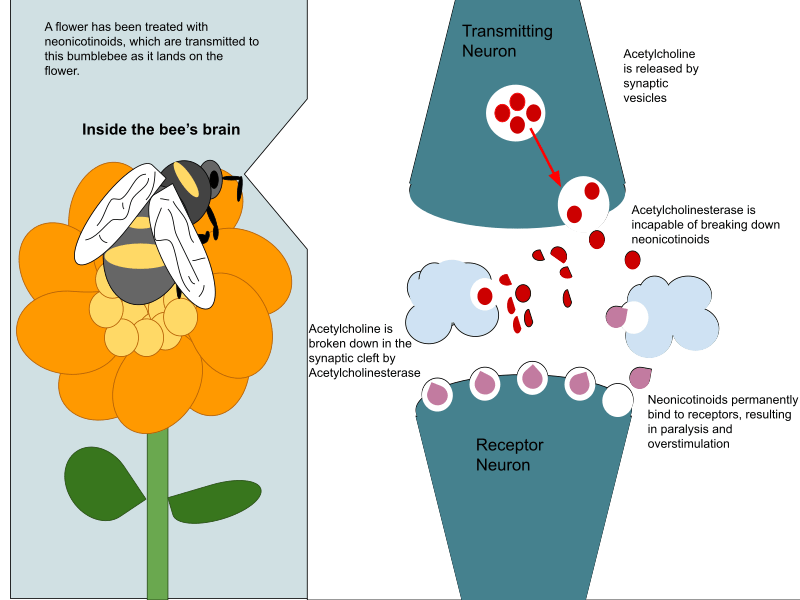The key difference between translaminar and systemic is that translaminar is a type of insecticide that travels only a shorter distance in the plant, while systematic is a type of insecticide that travels throughout the plant. Organic or inorganic substances that are used to kill insects are called insecticides. These chemicals have a wide range of applications in the field of medicine, agriculture, industry, and household. However, they are mainly used in agriculture. Insecticides have the potential to change the ecosystem component and are very toxic to certain animals and humans. Moreover, some insecticides become concentrated as they spread in the food chain. There are mainly three types of insecticides based on the mode of action: translaminar, systemic, and contact.
What is a Translaminar Insecticide?
Translaminar is a type of insecticide that travels only shorter distances in the plant. Translaminar insecticides penetrate into the plant tissue and move within a plant organ such as a leaf. After penetrating leaf tissues, they form a reservoir of active ingredients within the leaf. However, they do not travel to other parts of the plant. For example, these chemicals may move from the upper to the lower surface of a leaf.
Translaminar insecticides are active against a number of plant-feeding insects, such as two-spotted spider mites (Tetranychus urticae), leafminers, and thrips. Translaminar insecticides may also have contact activity. Some examples of translaminar insecticides may include abamectin, chlorfenapyr, extoxazole, pyriproxyfen, spinosad, and spiromesifen.
What is a Systemic Insecticide?
Systematic is a type of insecticide that travels throughout the plant. Systematic insecticides are absorbed and transported throughout the plants. These types of insecticides are introduced into the soil for them to get absorbed by the roots of the plants. Once systematic insecticides enter the root, they move to external surfaces like leaves, fruits, twigs, and branches. Systematic insecticides form a layer on the plant’s surface area and act as a poison for insects that harm the plant. They can render some or all toxicity to insects that normally feed on plant tissue. Therefore, they are commonly used to suppress herbivorous sucking or chewing insects like aphids, caterpillars, and root nematodes. However, systematic insecticides harm both target insects and non-target beneficial insects.
Systemic insecticides may include chemicals like neonicotinoids, which have been widely recognized for their risk. This is because they are very toxic to bees than most other insecticides and are also very persistent in the environment for a long period. Moreover, nearly 40 other systematic insecticides are currently used in the U.S. Some insecticides under this group include many newly approved chemicals as well. Some common examples of systematic insecticides are acephate, imidacloprid, dinotefuran, thiamethoxam, cyantraniliprole, and spirotetramat.
What are the Similarities Between Translaminar and Systemic Insecticides?
– Translaminar and systemic are two types of insecticides.
– Both insecticides are chemical in nature.
– They are absorbed into the plants.
– Both insecticides can travel through plants.
– Both insecticides are commercially available.
What is the Difference Between Translaminar and Systemic?
Translaminar is a type of insecticide that travels only shorter distances in the plant, especially in the leaf, while systematic is a type of insecticide that travels throughout the plant. Thus, this is the key difference between translaminar and systemic insecticides. Furthermore, translaminar insecticides normally persist for 14 days in the environment, while systemic insecticides normally persist for 100 days in the environment.
Summary – Translaminar vs Systemic
Insecticides are used to kill insects. They are mainly used for agricultural purposes. Insecticides are mainly of three types; they are translaminar, systemic, and contact. Translaminar insecticides travel only shorter distances in the plant. Normally, they travel from the upper surface of the leaf to the lower surface of the leaf. In contrast, systematic insecticides travel throughout the plant. Once they are absorbed from the roots, they travel all over the plant. So, this is the key difference between translaminar and systemic.
Key Takeaways
– Translaminar insecticides travel only shorter distances in the plant, while systemic insecticides travel throughout the plant.
– Translaminar insecticides are active against certain plant-feeding insects, while systemic insecticides can suppress herbivorous sucking or chewing insects like aphids, caterpillars, and root nematodes.
– Translaminar insecticides persist for 14 days in the environment, while systemic insecticides persist for 100 days in the environment.
